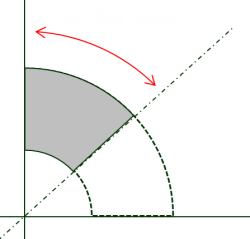About Cut Elbow | ||
| ||
There are two different ways to define a cut elbow:
- The part has the DS Fluidic Parameters and the instantiation rule is reuse reference (elbow or miscellaneous class).
- The part has an elbow class and the instantiation rule attribute is reuse or new reference.
DS Fluidic Parameters
If a miscellaneous or an elbow class has a set of attributes called DS Fluidic Parameters and contains an attribute called Cut_Elbow_Angle with an angle magnitude, then this class is managed as a cut elbow. This means that you modify the Cut_Elbow_Angle attribute to modify the angle. There is no maximum value for the cut angle.
Elbow Class
If a part has an elbow class, the Instantiation Rule attribute sets as New Reference or Reuse or New Reference and the Reference Mode value is New from, the part is managed as a cut elbow.
The angle of a cut elbow corresponds to the bend angle attribute and its maximum value corresponds the reference bend angle attribute. These two attributes are defined on the elbow class. For more information, see Behavior Detail of Raceway Class.
The following red arrow represents the bend angle and the whole angle is the reference bend
angle.
Cut Elbow Instantiation
A dedicated rule is integrated in CATIA on the cut elbow class to automatically apply the right instantiation rule. When the instantiation rule is Reuse or New Reference, the following rule is applied:
- if the bend angle value of the route is equal to the bend angle value of the cut elbow, the instantiation rule is Reuse
- if the bend angle value of the route is less than the bend angle value of the cut elbow, the instantiation rule is New Reference and the cut elbow is duplicated.